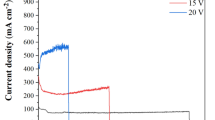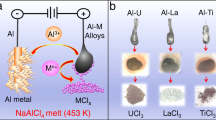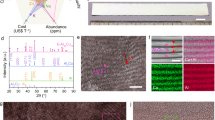Abstract
THE common technique for removing anodic oxide film from aluminium alloys is by dissolution of the metal substrate or attack along the metal–oxide interface using a bromine–methanol solution1,2, or a mercuric chloride solution3. Both these procedures are slower, offer more risk of contamination of the oxide and yield smaller pieces of intact film than the electrolytic detachment technique developed by Lacombe and Beaujard4.
This is a preview of subscription content, access via your institution
Access options
Subscribe to this journal
Receive 51 print issues and online access
$199.00 per year
only $3.90 per issue
Buy this article
- Purchase on SpringerLink
- Instant access to full article PDF
Prices may be subject to local taxes which are calculated during checkout
Similar content being viewed by others
References
Werner, O. Z., Anal. Chem., 121, 391 (1941).
Pearson, E. C., Huff, H. J., and Hay, R. H., Canad. J. Tech., 30, 311 (1952).
Wernick, S., J. Electrodepositors Tech. Soc., 9, 153 (1934).
Lacombe, P., and Beaujard, L., Metaux Corrosion-Usure, 20, (4), 43 (1945).
Spooner, R. C., and Roberts, J. M., Metal Progress, 67 (6), 109 (1955).
United States Patent 3,023,149.
Author information
Authors and Affiliations
Rights and permissions
About this article
Cite this article
SPOONER, R. Electrolytic Detachment of Anodic Oxide Films on Aluminium Alloys. Nature 197, 995–996 (1963). https://doi.org/10.1038/197995a0
Issue date:
DOI: https://doi.org/10.1038/197995a0



